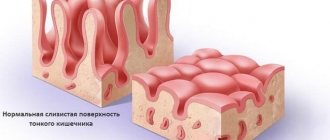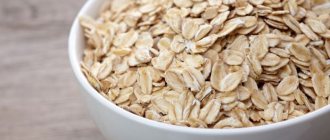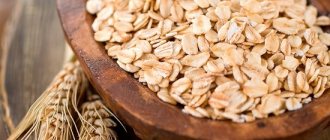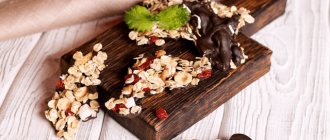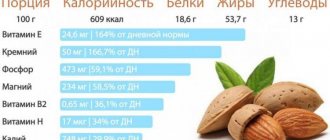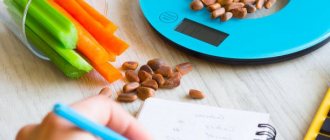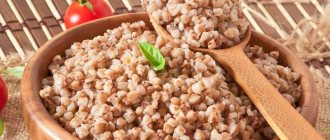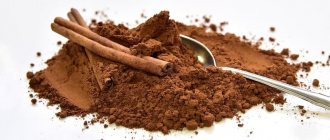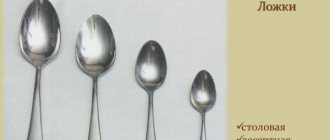Since scales are not always available at home, the recipes give the dosage of products in tea and faceted glasses, tablespoons and teaspoons.
How many grams are in a tablespoon and a teaspoon? How many grams of flour are in a glass? How many grams of salt or sugar are in a tablespoon or teaspoon? From the table you will learn that one tablespoon contains 30 grams of salt and 25 grams of sugar. And in one faceted glass there are 200 grams and 200 ml of water. And in one glass there are 100-130 grams of flour and 18 grams of sugar.
Below are the approximate weights (grams) of some products in these quantities.
| Product | tea glass (250 ml) | faceted glass (200 ml, up to the marks) | tablespoon | tea spoon |
| Water | 250 | 200 | 18 | 5 |
| Peanuts, shelled | 175 | 140 | 25 | 8 |
| Jam | 330 | 270 | 50 | 17 |
| Fresh cherries | 190 | 150 | 30 | 5 |
| Peas | 230 | 205 | 25 | 5 |
| Peas, unshelled | 200 | 175 | — | — |
| Dried mushrooms | 100 | 80 | 10 | 4 |
| Gelatin powder | — | — | 15 | 5 |
| Fresh strawberries | 170 | 140 | 25 | 5 |
| Raisin | 190 | 155 | 25 | 7 |
| Cocoa powder | — | — | 12 | 5 |
| Citric acid (crystalline) | — | — | 25 | 8 |
| Fresh strawberries | 150 | 120 | 25 | 5 |
| Ground cinnamon | — | — | 20 | 8 |
| Ground coffee | — | — | 20 | 7 |
| Starch | 180 | 150 | 30 | 10 |
| Rolled oats | 70 | 50 | 12 | 3 |
| Buckwheat | 210 | 165 | 25 | 7 |
| Semolina | 200 | 160 | 25 | 8 |
| Pearl barley | 230 | 180 | 25 | 8 |
| Millet groats | 220 | 170 | 25 | 8 |
| Rice groats | 240 | 180 | 25 | — |
| Barley groats | 180 | 145 | 20 | 5 |
| Corn flour | 160 | 130 | 30 | 10 |
| Liquor | — | — | 20 | 7 |
| Mayonnaise | 250 | 210 | 25 | 10 |
| Poppy | 155 | 135 | 18 | 5 |
| Fresh raspberries | 140 | 110 | 20 | 5 |
| Melted margarine | 230 | 180 | 15 | 4 |
| Melted animal butter | 240 | 185 | 17 | 5 |
| Vegetable oil | 230 | 190 | 17 | 5 |
| Ghee | 240 | 185 | 20 | 8 |
| Honey | 325 | 265 | 35 | 12 |
| Almond (kernel) | 160 | 130 | 30 | 10 |
| Condensed milk | 300 | 250 | 30 | 12 |
| Powdered milk | 120 | 100 | 20 | 5 |
| Whole milk | 250 | 200 | 20 | 5 |
| Wheat flour | 160 | 100-130 | 25 | 8 |
| Hazelnut (kernel) | 170 | 130 | 30 | 10 |
| Crushed nuts | 170 | 130 | 30 | 10 |
| Ground pepper | — | — | 18 | 5 |
| Fruit puree | 350 | 290 | 50 | 17 |
| Rice | 230 | 180 | 25 | 8 |
| Fresh rowan | 160 | 130 | 25 | 8 |
| Sago | 180 | 160 | 20 | 6 |
| Sawed sugar | 200 | 140 | — | — |
| Granulated sugar | 200 | 180 | 25 | 8 |
| Powdered sugar | 180 | 140 | 25 | 10 |
| Cream | 250 | 210 | 25 | 10 |
| Sour cream | 250 | 210 | 25 | 10 |
| Drinking soda | — | — | 28 | 12 |
| Salt | 320 | 220 | 30 | 10 |
| Ground crackers | 125 | 100 | 15 | 5 |
| Tomato paste | 300 | 250 | 30 | 10 |
| Vinegar | 250 | 200 | 15 | 5 |
| Cornflakes | 50 | 40 | 7 | 2 |
| Oat flakes | 100 | 80 | 14 | 4 |
| Wheat flakes | 60 | 50 | 9 | 2 |
| Dry tea | — | — | 3 | — |
| Black currant | 180 | 130 | 30 | — |
| Egg powder | 100 | 80 | 25 | 10 |
Delicious recipe!
How to beautifully name your beloved man It is advisable, using a scale or beaker, to measure the capacity of glasses and spoons with water. As can be seen from the table, there should be 250 g (ml) of water in a tea glass, 200 g in a faceted glass, 18 g in a tablespoon, and 5 g in a tea glass.
If the dishes have a different capacity, you should try to select the dishes of the required capacity, which will serve as a constant measure for all products.
Liquid products (milk, vegetable oil) must be filled completely into glasses and spoons.
Viscous products (sour cream, condensed milk, jam) should be placed in glasses and scooped with a spoon so that a “slide” is formed.
The same applies to bulk products. Flour should be poured into glasses, since when scooping it up by immersing the glass in a bag of flour, voids will form inside the glass along the walls due to the air remaining in it.
It is necessary to fill the dishes with bulk products without compacting or shaking, and also without preliminary loosening. This especially applies to flour. Thus, flour in a normally heaped tea glass weighs 160 g, and compacted flour weighs up to 210 g, while pre-sifted flour weighs only 125 g. As a result, bulk products must be measured for preparing products in unsifted form, and then sifted. A bowl filled with flour is shown in the figure.
On a note
In recipes, to shorten the presentation, it is written not “faceted glass”, but “glass”.
If the humidity and condition of the product deviate from the norm, its weight in the same volume changes. So, fermenting sour cream is lighter than fresh, unfermented one; sugar and salt with high humidity are heavier than normal.
Modern society is increasingly thinking about healthy eating. After all, it is becoming increasingly difficult to find truly healthy and environmentally friendly products on store shelves. One such product is oatmeal. A tasty and healthy oatmeal porridge is prepared from these flakes. That's why oatmeal is often called oatmeal. People who pay attention to proper diet choose oatmeal (oatmeal) for breakfast. It has been scientifically proven that oatmeal is a light and healthy food. Which is a very good way to start your day. But in order to prepare a truly tasty and light oatmeal porridge, you need to follow the proportions according to the recipe. Very often in recipes the amount of ingredients is measured in grams. But there are not always scales available to measure weight in grams; fortunately, you can use an ordinary spoon. This is what our article will be about, we will answer the question how many grams of oatmeal are in a tablespoon and a teaspoon.
Attention! Recipes are very good to use when you need to calculate the number of servings. This is good when you are afraid to cook a little or a lot.
How many grams are in a tablespoon of oatmeal (oatmeal)?
1 tablespoon holds 16 grams of oatmeal (heaped)
One tablespoon contains 12 grams of oatmeal (without a slide)
In the table below, the calculations were carried out with ordinary dry oatmeal of the Hercules type, which is the most popular in our latitudes.
| Type of spoon | Weight in grams | Calorie content of a spoon |
| A heaping tablespoon of oatmeal is | 16 grams | 56 calories |
| A level tablespoon of oatmeal is | 12 grams | 42 calories |
| A heaping teaspoon of oatmeal is | 6 grams | 21 calories |
| A level teaspoon of oatmeal is | 4 grams | 14 calories |
Table weight of prepared (raw) oatmeal in a spoon
| Type of spoon | Weight in grams |
| A heaped tablespoon of boiled oatmeal is | 35 grams |
| A level tablespoon of boiled oatmeal is | 25 grams |
| A heaped teaspoon of boiled oatmeal is | 15 grams |
| A level teaspoon of boiled oatmeal is | 7 grams |
Delicious recipe! How to bake potatoes in a sleeve in the oven
The weight of the finished oatmeal may vary! It all depends on how thick or thin the oatmeal you prepared. In our table, we took the average value.
Attention! Oatmeal (oatmeal) is not only porridge, but rather it is the fastest way to get a tasty and healthy dish. Oatmeal is even used in cosmetology and medicine.
Benefits of oatmeal
Oatmeal flakes contain a large amount of vitamins and fiber. This porridge stabilizes cholesterol levels and is useful for people suffering from high blood sugar.
| Daily value per 100 g. | ||
| Vitamin E | 0.4 mg | 2,9% |
| Vitamin K | 2.0 mcg | 1,7% |
| Vitamin B1 | 0.5 mg | 38,3% |
| Vitamin B2 | 0.2 mg | 11,9% |
| Vitamin B3 | 1.1 mg | 7,0% |
| Vitamin B4 | 40.4 mg | 8,1% |
| Vitamin B5 | 1.1 mg | 22,4% |
| Vitamin B6 | 0.1 mg | 7,7% |
| Vitamin B9 | 32.0 mcg | 8,0% |
| Daily value per 100 g. | ||
| Calcium | 52.0 mg | 5,2% |
| Iron | 4.3 mg | 42,5% |
| Magnesium | 138.0 mg | 34,5% |
| Phosphorus | 410.0 mg | 58,6% |
| Potassium | 362.0 mg | 7,7% |
| Sodium | 6.0 mg | 0,5% |
| Zinc | 3.6 mg | 33,1% |
| Copper | 0.4 mg | 43,4% |
| Manganese | 3.6 mg | 157,8% |
| Selenium | 28.9 mcg | 52,5% |
| Daily value per 100 g. | ||
| Tryptophan | 0.182 g | 22,8% |
| Threonine | 0.382 g | 15,9% |
| Isoleucine | 0.503 g | 25,2% |
| Leucine | 0.980 g | 21,3% |
| Lysine | 0.637 g | 15,5% |
| Methionine | 0.207 g | 11,5% |
| Cystine | 0.455 g | 25,3% |
| Phenylalanine | 0.665 g | 15,1% |
| Tyrosine | 0.395 g | 9,0% |
| Valin | 0.688 g | 27,5% |
| Arginine | 0.850 g | 13,9% |
| Histidine | 0.275 g | 13,1% |
| Alanin | 0.563 g | 8,5% |
| Aspartic | 1.217 g | 10,0% |
| Glutamic | 2.830 g | 20,8% |
| Glycine | 0.642 g | 18,3% |
| Proline | 0.451 g | 10,0% |
| Serin | 0.705 g | 8,5% |
Oatmeal is the best start to the day for those who take care of their body, as well as the health of their child.
There are 379 kcal per 100 grams of product. 13.2 g protein, 6.5 g fat, 67.7 g carbohydrates.
Recipe
The ratio of oatmeal to water is 1.5:2. That is, for 1.5 cups of cereal you need 2 cups of water.
- We need 2 cups of oatmeal, a liter of water, butter and salt and sugar to taste.
- As soon as the water in the pan begins to boil, pour the flakes into the water and add salt and sugar to taste.
- While cooking, slowly stir the flakes until completely cooked. If you don't stir the porridge, it will burn on the pan. Cooking time 15 - 20 minutes. Time may vary due to flake size (whole oats) and heat level. Large flakes take longer to cook, but also contain more vitamins. Whole grains are cooked for up to 40 minutes.
- When the mass in the pan begins to look like porridge, turn off the gas and add butter to taste.
Useful properties of oatmeal
This cereal is not only the healthiest, but also one of the components of dietary dishes. It can be prepared with either water or milk. Oatmeal is made from oats, which can be considered a young crop.
To obtain oat flakes, it is customary to first grind them, and only then flatten them. Then the resulting product is squeezed out of the oil, and everything that comes out is subjected to heat treatment.
After all these procedures, oatmeal turns out fragrant and crispy. The difference between the grains themselves and the flakes is insignificant. It is from grains that oatmeal and bran are usually made.
Porridge is useful not only for children, but also for adults. It contains a fairly large amount of vegetable protein, which is the one that provides the greatest energy value.
Oatmeal can be considered an excellent absorbent, which is why it is so important to consume it daily for people who live in vast industrial regions.
How to choose oatmeal
Instant cereal contains fewer vitamins and minerals due to processing during the manufacturing process. The glycemic index of such products is high and therefore the rate of digestion of carbohydrates and their conversion into sugar is high.
If you are watching your figure and health, then oatmeal should be made only from whole grain oatmeal. This is a cereal and visually it looks nothing like flakes. Also, if you want to monitor your health, but cook the cereal for too long, look for crushed cereal on the store shelves. It contains less fiber, but it is better than cereal cooked in 5 minutes.
Scottish porridge recipe
Porridge - this dish has become national in Scotland. Liquid oatmeal, cooked only from whole or crushed oatmeal. The cooking process itself is no different, but sugar or salt and other additives are not added to this porridge. Porridge is prepared exclusively with water. During the cooking process, salt, oil and other additives prevent the oatmeal from revealing its flavor.
The Scots know a lot about oatmeal and therefore more than 80% of the national cuisine uses oatmeal.
- October 12, 2018
- Second courses
- Garfutdinova Svetlana
There is a place for perfectionism in life. As well as diets and proper nutrition. For example, the nutritionist ordered, and hinted at a healthy lifestyle: take 100 grams of oatmeal in the morning on an empty stomach. It’s also good if you allow it to be brewed with boiling water (worse - if you use soy milk).
What if you are an obedient person? They said one hundred grams means one hundred grams, not a gram more, not a gram less. So what, run for a pharmacy scale? No! Read our article.
Calorie content of oatmeal with additives
Oatmeal with banana on water - 103-128 kcal
Oatmeal with honey - 117 kcal
Oatmeal with kefir - 112 kcal
Oatmeal in a jar - 184 kcal (with yogurt, raisins, nuts). The calorie content of lazy oatmeal depends on the additives chosen.
Important! If you decide to sweeten the porridge with sugar, honey or jam, or add fruit or dried fruits, be aware that this will also affect the calorie content.
Oatmeal with raspberries
Calorie content of the dish: 43 kcal
View recipe
Oatmeal with prunes
Calorie content of the dish: 141 kcal
View recipe
Oatmeal with strawberries
Calorie content of the dish: 117 kcal
View recipe
Oatmeal or rolled oats?
The easiest way to measure 100 grams of oatmeal is with tablespoons. They are always at hand. So, 100 grams of oatmeal is how many spoons?
Oatmeal is also different, so we have prepared what you need to measure with spoons:
- dry oatmeal;
- dry oat flakes.
And, of course, a tablespoon.
So, we have 100 grams of oatmeal and 100 grams of dry oat flakes in separate containers. Carefully scoop them out and pour them into another container with a tablespoon. But spoons come with a slide and without a slide. Let's try both options.
Quick navigation
- Calorie content of oatmeal on water
- Calorie content of oatmeal with milk
- Calorie content of oatmeal with additives
- How many calories are in a tablespoon of oatmeal?
- 3 fun oatmeal recipes (video recipes)
- Links to selections of different oatmeal recipes
In this article we will try to understand the issues related to the calorie content of oatmeal, oatmeal and oatmeal. There are different types of oatmeal on store shelves, the methods of preparing oatmeal can also be different, and the calorie content of the dish as a whole depends on all this.
Read our short article on the topic of calorie content of oatmeal and many questions will be resolved by themselves. At the very end, we will share with you examples of healthy oatmeal dishes with calorie content.
Dry product in level tablespoons
The second option is without a slide. Let's see, 100 grams of oatmeal is how many tablespoons.
Hint: it is more convenient to level the level of the spoon using a knife. Scoop up the cereal and use a knife blade to run along the edges, “cutting off” the excess. The spoon will be filled exactly to the brim.
So, let's start the process. We scoop it up, remove the excess with a knife, pour it over. And so on until the containers are empty. At the same time, we carefully keep count of our spoons.
What happened in the end? Containers with 100 grams of our initial dry content are equal to:
- 8 tbsp. spoons of dry cereal;
- 9 tbsp. spoons of dry oatmeal.
But maybe you shouldn’t bother with these tablespoons every morning, with or without a slide? Maybe to save time, let's cook oatmeal for the whole week? And when it’s ready, let’s measure 100 grams of oatmeal into a plate, wash it down with a cup of coffee and run about our business? Do you agree? Then we move on to measurement.
Oatmeal 30 grams in dry form. Weight
Topic: measure the weight of a product in grams (g, g).| What do we use in this case to determine weight without scales and weighing. | Where is it recommended to use this method of measuring weight without weighing on a scale. | Conditions for using the method. | Quantity. | The accuracy of determining the quantity using this method. | |
| WITH A TEA SPOON (measure with teaspoons, a way to find out the weight of Hercules petals without weighing on a scale) | Regular cutlery | Cooking, in the kitchen | 12.5 teaspoons | Approximately | |
| How to measure 50 grams (g, g) of oatmeal with a TABLE SPOON (measure with tablespoons, a way to find out the weight of Hercules petals without weighing on a scale) | Regular cutlery | Cooking, in the kitchen | On your own, at home | 3 tablespoons + 2 teaspoons | Approximately |
| How to measure 50 grams (g, g) of oatmeal with a FACETED GLASS (measure with faceted glasses, a way to find out the weight of Hercules petals without weighing on a scale) | Standard glassware for drinks | Cooking, in the kitchen | On your own, at home | 1/2 cup + 1 tablespoons + 1 teaspoons | Approximately |
| How to measure 50 grams (g, g) of oatmeal with a REGULAR GLASS (measure with standard glasses, a way to find out the weight of Hercules petals without weighing on a scale) | Standard glass beverage container | Cooking, in the kitchen | On your own, at home | 1/2 cup | Approximately |
| How to measure 50 grams (g, g) of oatmeal IN LITERS (measure in liters, in liter jars, a way to find out the weight of Hercules petals without weighing on scales) | Volume units and standard liter jar | Cooking, in the kitchen | On your own, at home | 0.125 liters | Exact ratio |
| How to measure 50 grams (g, g) of oatmeal in ML (measure in milliliters, milliliters, a way to find out the weight of Hercules petals without weighing on a scale) | Volume units | Cooking, in the kitchen | On your own, at home | 125 ml | Exact ratio |
| How to measure 50 grams (g, g) of oatmeal IN CUBIC CENTIMETERS (measure in cm3, cubic cm cubes, a way to find out the weight of Hercules petals without weighing on a scale) | Volume units | Cooking, in the kitchen | On your own, at home | 125 cm3 | Exact ratio |
How to measure 50 grams (50 gr, 50 g) of oatmeal using tablespoons and teaspoons.
The first way to measure 50 grams of dry oatmeal without weighing it on a scale is to measure the product using a spoon. Spoons, tea or table spoons, are convenient because they are always at hand. It is difficult to imagine a kitchen where we would not find this popular “household measuring device”, known to any housewife. It seems to me that no one needs special training to use tablespoons and teaspoons. Although, it is worth explaining that all methods of measuring a product with a tablespoon or teaspoon are always based on the fact that a portion is measured correctly only when we follow one important measurement rule. Which? You need to scoop up the product with a spoon carefully, without a slide. That very mound that is so easily obtained when measuring the product is not a trifle at all and cannot be neglected. It introduces a significant error into any calculations of the quantity of a product, overestimating (increasing) its quantity, weight in grams, compared to what you expect when measuring yourself at home. It is especially important to follow this rule when measuring portions of loose, grainy, granular, lumpy foods and ready-made dishes. In cases where we want to measure 50 grams (g, g) of liquid, the problem goes away by itself. Since liquids in teaspoons and tablespoons do not create a large slide. And the volume of the measured product will practically coincide with the capacity in milliliters declared by the manufacturer of the spoon. In order to measure a portion of sugar without scales, when compiling our table, the following volumes of a tablespoon and a teaspoon were selected:
- The volume of a teaspoon of oat petals and flakes is 5 milliliters (ml), which is 5 cubic centimeters (cm3, cc).
- The volume of a tablespoon of oatmeal and flakes is 15 milliliters (ml), which is 15 cubic centimeters (cm3, cc).
However:
the indicated volume of a teaspoon and a tablespoon does not take into account one important feature of independent measurements of the amount of dry oatmeal. When measuring a portion with a tablespoon or teaspoon, you can scoop up the product in a small heap. Therefore, formal ratios like: 1 tablespoon of oatmeal = 3 teaspoons do not work in all situations. Accurate measurements of weight and quantity will always result in some difference.
The idea of a method for independently measuring the weight (mass) of rolled oatmeal equal to 50 grams using a tablespoon or teaspoon is that there is a proportional relationship between the weight of dry oatmeal and its volume.
Determined from a physical point of view by the bulk density of the product. Bulk density itself, by definition of this physical quantity, is the weight of a certain volume taken per unit. Typically, bulk density, in terms that may be relevant to cooking and measuring portions at home, is the weight of one milliliter (ml). Or, how many grams are in 1 milliliter (ml) of oat petals and flakes. Knowing how many grams 1 ml weighs, we can say exactly how much one teaspoon will weigh and how much 1 tablespoon of dry oatmeal will weigh in grams. After all, their capacity (volume) is well known to us in advance and we can consider spoons (with some stretch, of course) as standard utensils. This makes it possible for us to use spoons to measure a portion of rolled oatmeal by weight in grams, without weighing it on a scale. How to measure 50 grams (50 gr, 50 g) of oatmeal - measure with standard and cut glass glasses.
The second way to measure 50 grams of dry oatmeal without weighing it on a scale is to measure the product using a glass. In addition to spoons, in the kitchen we always have another fairly convenient “household measuring instrument” - glasses, goblets, wine glasses, mugs and cups: drinking utensils. With mugs and cups (ceramic and glass) there is a separate conversation; too many varieties of cups with different designs, sizes and, as a result, different capacities can be found in the store. I would not recommend considering glasses, wine glasses, cups as standard tableware. Except in cases where you already know exactly their capacity in advance. But glasses are really standard glassware, quite suitable for measuring dry oatmeal flakes. With the clarification that there are two standards for glasses according to their capacity in milliliters. These two types of glass glasses also differ in design. We can always visually determine at first glance which option we have in our kitchen: a thin-walled (thin) glass glass or a faceted glass glass. In those rare situations when you are unsure or in doubt, it is easy to clarify the type of glass. How to do it? Here, it will be more convenient and faster to use the Internet. “Taking in” the following queries in Yandex or Google search: a faceted glass photo or an ordinary glass photo. From the image in the photo you will see how the characteristic design of a faceted glass differs from the appearance of an ordinary standard glass. As for their capacity, the number of milliliters (ml) of oat petals and flakes that fit in different glasses, the following proportions exist (and are strictly observed by manufacturers):
- The volume of an ordinary glass glass is 250 milliliters (ml), which is 250 cubic centimeters (cm3, cc).
- The volume of a faceted glass glass is 200 milliliters (ml), which is 200 cubic centimeters (cm3, cc).
Please note:
although the volume of a cut glass or an ordinary glass glass in milliliters (ml) is always observed by the glassware manufacturer with fairly high accuracy, we are not always able to as accurately identify the fractional parts of the glass “by eye”. If you are in doubt or have not encountered such a task before, or do not have experience in measuring with a glass, it would be wise to find a photo on the Internet with additional information on this particular issue. What should you look for? An image or picture where the glass is conventionally equipped with a scale on which the fractional parts (shares) of the glass are marked. In order to confidently measure a portion of dry oat flakes, as a rule, it is enough to enter one of the following questions in the search:
- What does 1/2 cup of oat flakes look like in the photo (one half, half, half).
- What does 1/3 cup of oat flakes look like in the photo (one third, one third).
- What does 1/4 cup of rolled oats look like in the photo (one fourth, quarter).
- What does 1/5 cup of oat flakes look like in the photo (one fifth).
- What does 2/3 cup of oat flakes look like in the photo (two thirds).
- What does 3/4 cup of rolled oats look like in the photo (three quarters, three fourths).
- What does 2/5 cup of oat flakes look like in the photo (two fifths).
The idea of a way to independently measure the weight (mass) of rolled oatmeal equal to 50 grams using a glass is that there is a proportional relationship between the weight of dry rolled oat flakes and their volume.
As in the case of spoons, it is determined from a physical point of view, by the specific gravity of the product. Specific gravity itself, by definition of this physical quantity, is the mass of a certain volume taken per unit. Typically, bulk density, in terms that may be relevant to cooking and measuring portions at home, is the weight of one milliliter (ml). Or, how many grams are in 1 milliliter (ml) of oatmeal. Knowing how many grams 1 ml weighs, we can say exactly how much one standard glass will weigh and how much 1 cut glass of dry oatmeal will weigh in grams. After all, their capacity (volume) is well known to us in advance and we can consider glasses as standard tableware. This makes it possible for us to use glasses to independently measure portions by weight in grams, without weighing them on scales. How to measure: 50 grams (50 gr, 50 g) of oatmeal in ml (milliliters) and liters (l).
If we want to know how many liters it is - 50 grams of oat petals and flakes
, then the table located on this page of the site will help us. Naturally, there is no direct relationship or generally accepted “school” rules for converting grams into liters. Grams (g, g) are units of weight or mass, and liters (l) are units of volume. It is impossible to automatically convert grams into liters without taking into account the features and properties of a particular product. However, if you approach the matter wisely and think, then nothing is impossible. From a physical point of view, we again look at the density of dry oatmeal. So, the weight of a serving that we know is 50 grams. We measure volume in liters. Fine. The simplest way to tie everything together: grams, liters and density is bulk density. By definition, bulk density is the density or specific gravity of a certain unit volume. For example, one liter (l). The volumetric density of oatmeal is accessible reference information and knowing how many grams 1 liter weighs, we can easily calculate how many liters are in 50 grams of oatmeal petals. In principle, I have no doubt that you can make the calculation yourself, but it will be more convenient to look at the ready-made answer in the table.
- The volume of a liter jar is 1 liter (1 L) or 1000 milliliters (ml), which is 1000 cubic centimeters (cm3, cc).
- The volume of a half-liter jar is 0.5 liters (0.5 l, half liter) or 500 milliliters (ml), which is 500 cubic centimeters (cm3, cc).
Given that the correct ratios
between liters, milliliters and cubic centimeters are accurate reference proportions between different units of volume, measure yourself at home:
- - liter jars of oatmeal are best in large portions, when the amount we need is several liters (l) of oatmeal, but not fractional small portions of oatmeal.
- — milliliters (ml) are especially convenient to use when you need to measure small portions of dry oatmeal and we have a special measuring cup or dispenser equipped with a scale graduated in milliliters.
- — cubic centimeters (cm3) are wise to use for measuring small portions of oatmeal, also if you have a measuring cup or dispenser equipped with a special scale graduated in cubic centimeters (cc, cubes).
How to measure 50 grams (50 gr, 50 g) of oatmeal in cubic centimeters (cm3, cc).
If we want to know how many cubic centimeters (cm3) this is - 50 grams of oatmeal
, then you can immediately look at the answer in our table. As I noticed, many people know that it is possible to convert grams into liters (l) and milliliters (ml). But if you need to convert grams into cubic centimeters (cm3, cubic cm), then people often “hang” in a little bewilderment. Although, figuratively speaking, this is the same “Easter egg”, only “side view”. There is nothing problematic about cubic centimeters - these are also units of measurement for the volume of a product. It’s just that we are not used to working with cubic centimeters in cooking and in the kitchen. Purely psychological moment. In order to confidently do an independent recalculation and find out how many cubic centimeters there will be in 50 grams of rolled oat flakes. Given the known density of the product (volumetric weight), it is enough to recall the proportions known to us from school:
- 1 cubic centimeter (1 cm3, 1 cc) of dry oat flakes is equal to 1 milliliter (ml).
- 1 liter (1 L) of dry oat flakes is equal to 1000 cubic centimeters (cm3, cc).
- 1 cubic meter (1 m3, 1 cubic meter, 1 cubic meter) of dry oat flakes is equal to 1000 cubic centimeters (cm3, cc).
All other calculations will be performed approximately the same as in those cases when we acted with teaspoons, tablespoons, faceted glasses, standard glasses, liters and milliliters.
Reviews. 50 grams of dry oatmeal, how to determine without scales. Different ways to find out the weight of a portion without weighing on a scale. You can ask questions, leave reviews, comments, remarks and suggestions for the article: 50 grams, 50 grams, 50 grams of oat petals, rolled oats, how to measure without scales and without weighing yourself.
- In order to independently measure 50 grams (g) of oatmeal with a teaspoon without scales, you need to find out how many teaspoons.
- In order to independently measure 50 grams (g) of oatmeal with a tablespoon without scales, you need to find out how many tablespoons.
- In order to independently measure 50 grams (g) of oatmeal in a faceted glass without scales, you need to find out how many 200 ml glasses (faceted glass).
- In order to independently measure 50 grams (g) of oatmeal in a regular glass without scales, you need to find out how many 250 ml glasses (standard thin-walled, thin glass).
- In order to independently measure 50 grams (g) of oatmeal in liters without scales, you need to find out how many liters (l., liter cans).
- In order to independently measure 50 grams (g) of oatmeal in ml without scales, you need to find out how many milliliters (ml).
- In order to independently measure 50 grams (g) of oatmeal in cubic centimeters without scales, you need to find out how many cubic centimeters (cm3, cm3).

